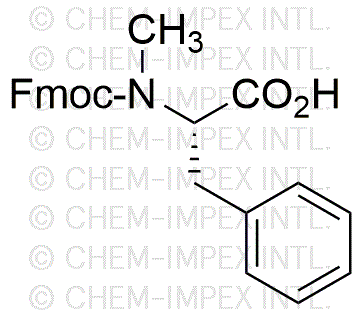Na-Fmoc-Na-methyl-L-phenylalanine is widely utilized in research focused on:
- Peptide Synthesis: This compound serves as a key building block in solid-phase peptide synthesis, allowing researchers to create complex peptides efficiently.
- Drug Development: It is used in the pharmaceutical industry to design and optimize peptide-based drugs, enhancing their efficacy and stability.
- Bioconjugation: The chemical is valuable in bioconjugation techniques, enabling the attachment of peptides to various biomolecules for targeted drug delivery systems.
- Protein Engineering: It aids in the modification of proteins, improving their properties for research and therapeutic applications, particularly in the field of biotechnology.
- Research in Neuroscience: This compound is explored in studies related to neurotransmitter function, contributing to a better understanding of neurological disorders.
Informations générales
Propriétés
Sécurité et réglementation
Applications
Na-Fmoc-Na-methyl-L-phenylalanine is widely utilized in research focused on:
- Peptide Synthesis: This compound serves as a key building block in solid-phase peptide synthesis, allowing researchers to create complex peptides efficiently.
- Drug Development: It is used in the pharmaceutical industry to design and optimize peptide-based drugs, enhancing their efficacy and stability.
- Bioconjugation: The chemical is valuable in bioconjugation techniques, enabling the attachment of peptides to various biomolecules for targeted drug delivery systems.
- Protein Engineering: It aids in the modification of proteins, improving their properties for research and therapeutic applications, particularly in the field of biotechnology.
- Research in Neuroscience: This compound is explored in studies related to neurotransmitter function, contributing to a better understanding of neurological disorders.
Documents
Fiches de données de sécurité (FDS)
La FDS fournit des informations de sécurité complètes sur la manipulation, le stockage et l’élimination du produit.
Spécifications du produit (PS)
Le PS fournit une description complète des propriétés du produit, notamment sa composition chimique, son état physique, sa pureté et les exigences de stockage. Il détaille également les plages de qualité acceptables et les applications prévues du produit.
Certificats d'analyse (COA)
Recherchez des certificats d'analyse (COA) en saisissant le numéro de lot du produit. Les numéros de lot et de lot se trouvent sur l'étiquette d'un produit, après les mots « Lot » ou « Lot de fabrication ».
Numéro de catalogue
Numéro de lot/série
Certificats d'origine (COO)
Ce certificat d'exploitation confirme le pays dans lequel le produit a été fabriqué, et détaille également les matériaux et composants utilisés et s'il est issu de sources naturelles, synthétiques ou autres sources spécifiques. Ce certificat peut être requis pour les douanes, le commerce et la conformité réglementaire.
Numéro de catalogue
Numéro de lot/série
Fiches de données de sécurité (FDS)
La FDS fournit des informations de sécurité complètes sur la manipulation, le stockage et l’élimination du produit.
DownloadSpécifications du produit (PS)
Le PS fournit une description complète des propriétés du produit, notamment sa composition chimique, son état physique, sa pureté et les exigences de stockage. Il détaille également les plages de qualité acceptables et les applications prévues du produit.
DownloadCertificats d'analyse (COA)
Recherchez des certificats d'analyse (COA) en saisissant le numéro de lot du produit. Les numéros de lot et de lot se trouvent sur l'étiquette d'un produit, après les mots « Lot » ou « Lot de fabrication ».
Numéro de catalogue
Numéro de lot/série
Certificats d'origine (COO)
Ce certificat d'exploitation confirme le pays dans lequel le produit a été fabriqué, et détaille également les matériaux et composants utilisés et s'il est issu de sources naturelles, synthétiques ou autres sources spécifiques. Ce certificat peut être requis pour les douanes, le commerce et la conformité réglementaire.


